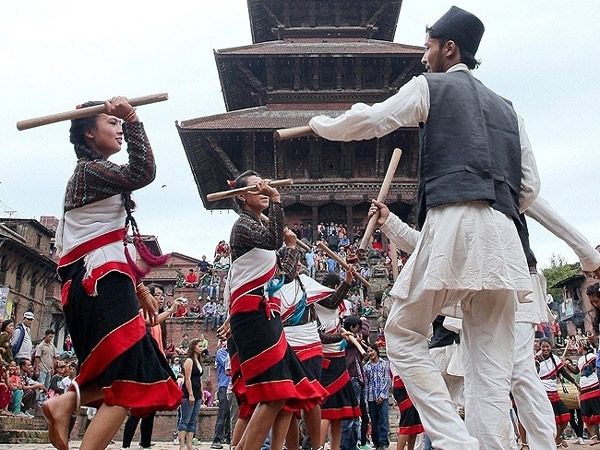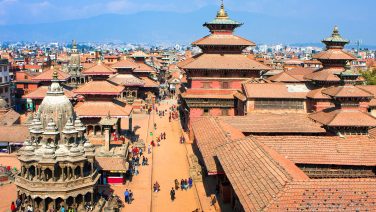Nepal is a small country located between India and China with a population of about 28 million people. In this dense country, there are many traditions and cultures that intermingle with one another. One of the caste systems with a rich history that covers 5% of the Nepali population is the Newar people.
The Newar people were the first group who lived in the Kathmandu valley that inspired Prithivi Narayan Saah to unite the country as he stood atop Chandragiri Hill. The culture and history of the Newar people are an important part of Nepal and worth discussing.
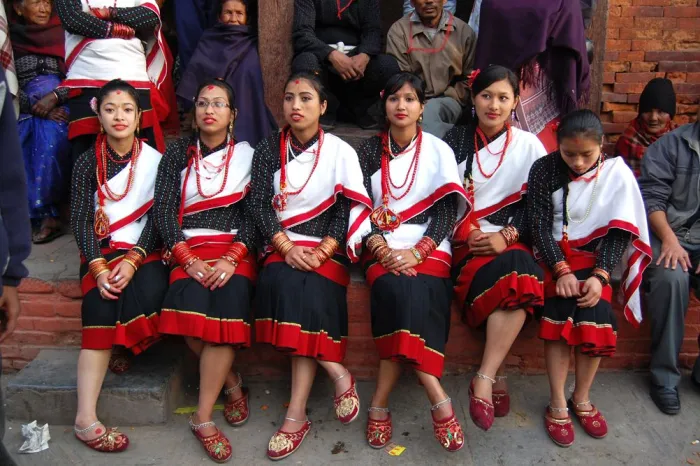
History
Before Nepal became the unified country it is today, they were small tribes of people who only met to trade goods. The king at that time was King Jayasthiti Malla. With the help of other higher caste Newars, called the Bramis, he segregated the group into four major Newar groups. These groups became the Brahmin, Kshatriya, Vaisya, and Shudra. The citizens were then put in each category depending on their occupation, with Brahmins being the nobles or the ruling class.
The Kshatriya were working-class people with an education. The Vaishya were also working-class people but were less educated, if at all. The lowest caste is the Shudras, who do not have access to education and do the work that no one else wants to do. After the country became united, the other groups also assimilated into one of these categories. That did not change the hierarchy of the different Newars staying in place as before.
The Newar caste people all had a different last name, which helps them identify each other with what kind of Newar they are. Each caste has a variety of different last names and with the mix of new Nepali people in the Kathmandu valley, there are people who are not Newar but have one of the Newar surnames, such as Malla, Sharma, and more.
The clash of religion and caste
The most common religion in Nepal is Hinduism, being 81% in the country. The second-largest religion is Buddhism, sitting at 8%. Newars had people in both religions and when the caste system came to be, these two groups also separated from one another.
The Hindu Newars put a greater emphasis on the nobles and royal blood, while the Buddhists set the monks and priests on a higher pedestal. Many of the Tibetan migrants also joined the Buddhist Newars as they grew in relation to one another by trading.
Who are the caste members called Shudra?
Shudra, also called Dalit, is the lowest caste in the Newar caste system. They are the uneducated and so-called uncivilized group of people. They spend their days working jobs that other people refuse to do and are barely make money for their hard work. All the other caste members look down on them, going so far as to refuse to touch them or anything they have touched. People do not even give the time of the day. Even to this day, with many Shudras working in better jobs, there is still a lot of segregation and discrimination towards these people.
Being at the bottom of the barrel has continuously kept them from attaining greater wealth to this day. Many Shudra people do not have money to afford to go to school. This leaves them begging for money and food on the streets. Due to their lack of education, they also do not have an accurate representation in higher-paying jobs or a justice voice in the courts. The Shudra people make up about 13% of the Nepali population and yet, they are still not given the same rights as other citizens.
Newar Clothing
Just as every cultural group has its own cuisine and clothing, the Newars do not disappoint. South Asian clothing usually consists of saris. They are a lengthy cloth that the person wraps around them and then becomes a drape on their shoulder. This is somewhat the same style for Newar clothing.
Women’s Clothing / Men’s clothing
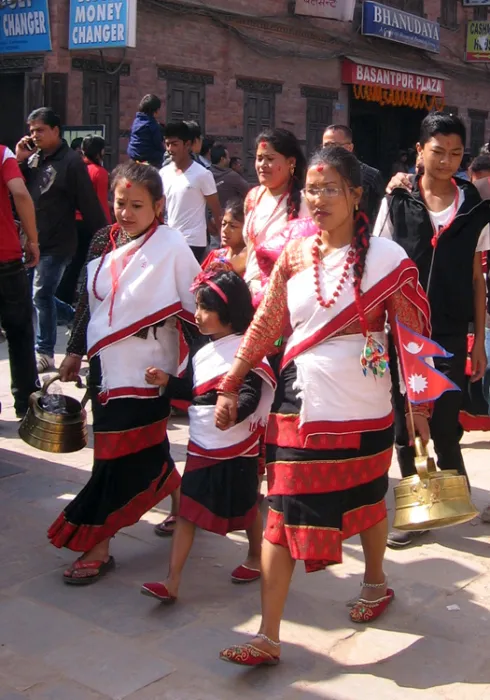

History
Before Nepal became the unified country it is today, they were small tribes of people who only met to trade goods. The king at that time was King Jayasthiti Malla. With the help of other higher caste Newars, called the Bramis, he segregated the group into four major Newar groups. These groups became the Brahmin, Kshatriya, Vaisya, and Shudra. The citizens were then put in each category depending on their occupation, with Brahmins being the nobles or the ruling class.
The Kshatriya were working-class people with an education. The Vaishya were also working-class people but were less educated, if at all. The lowest caste is the Shudras, who do not have access to education and do the work that no one else wants to do. After the country became united, the other groups also assimilated into one of these categories. That did not change the hierarchy of the different Newars staying in place as before.
The clash of religion and caste
The most common religion in Nepal is Hinduism, being 81% in the country. The second-largest religion is Buddhism, sitting at 8%. Newars had people in both religions and when the caste system came to be, these two groups also separated from one another.
The Hindu Newars put a greater emphasis on the nobles and royal blood, while the Buddhists set the monks and priests on a higher pedestal. Many of the Tibetan migrants also joined the Buddhist Newars as they grew in relation to one another by trading.
“While Rajopadhyaya Brahmins (or Déva-bhāju) occupied the highest social position in the Hindu side, the Vajracharya (or Guru/Gu-bhāju) formed the head among the Buddhists.” (Wikipedia)
Who are the caste members called Shudra?
Shudra, also called Dalit, is the lowest caste in the Newar caste system. They are the uneducated and so-called uncivilized group of people. They spend their days working jobs that other people refuse to do and are barely make money for their hard work. All the other caste members look down on them, going so far as to refuse to touch them or anything they have touched. People do not even give the time of the day. Even to this day, with many Shudras working in better jobs, there is still a lot of segregation and discrimination towards these people.
Being at the bottom of the barrel has continuously kept them from attaining greater wealth to this day. Many Shudra people do not have money to afford to go to school. This leaves them begging for money and food on the streets. Due to their lack of education, they also do not have an accurate representation in higher-paying jobs or a justice voice in the courts. The Shudra people make up about 13% of the Nepali population and yet, they are still not given the same rights as other citizens.
Newari Goddess
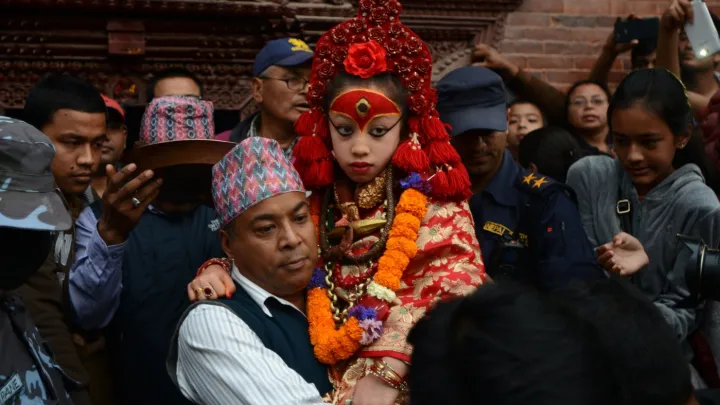
They found Nepal’s Royal Kumari a healthy girl child, without any cuts or scar on the skin, intact teeth will be the best fit. Once selected the kumari has to pass a test of 32-body perfection. A ritual is known as “Battis Lakshan”.
Criteria for 32 Body Perfections -some sample
- She should have a banyan like body
- Her eyelashes would be like that of a cow
- She should have a conch shaped neck
- Her voice must be as sweet as a duck
- She must have a chest like a lion
- Her Menstruation cycle ‘period’ should not be started , etc.
The living goddess Kumari is a popular site that hundreds of Nepali citizens go to visit each year. A Kumari is a girl born to a pure Newar family who must have no impurities and must live as a living goddess until the day she reaches womanhood. Womanhood is symbolized by her getting her first period. The belief is that once the current Kumari gets her period, the Teju, the god, leaves the woman and goes into the body of a new child. Every so often, a Newarni is picked from her family and is put through rigorous testing to see if she is the next living goddess. There is usually more than one girl who is picked. Through thorough inspections and testing, they pick the one that most closely matches the description of a Kumari. The tests are as followed:
Once a girl has been picked, she must live inside a special palace where she is prohibited from meeting her family. She is not allowed to walk without the assistance of her caregiver. If she were to smile or laugh, it is a symbol of impending doom or even the death of whoever she smiles at. If she picks at her food, then that is a sign of great financial loss. There are many other beliefs that go along with this goddess, but these are the main actions that people watch out for.
From her head to her toe, she is the embodiment of purity and goodness. People from all over Nepal stand outside her palace to catch even a glimpse of her. If people are able to go inside and visit her in person, they will bow their heads and touch her feet for blessing. Even the prime minister and president of Nepal visit her to seek her blessings.
The life after Kumari
When the young Kumari has her first period, it represents God leaving her body. God is moving on to their next vessel. The now ex-Kumari is then removed from the palace walls and left to fend for herself. People who once looked up to the girl as a goddess now shun her and refuse to touch her, as she is no longer the pure being she once used to be.
Many of these girls have never done anything for themselves and have no idea about even the most basic of things. This makes it difficult for them to live a normal life outside the palace walls. Some are alone and have no family to go back to. This leads them to a negative place. They end up having to live the rest of their lives on the street. Those who do have families to go back to, do so and try to live as normal of a life as they can once again.
Nowadays, Kumaris who go back to living normal lives are given the opportunity to have an education that they were not able to have before. Many go to public schools and live normal lives and a few attend school through private tutors.
Newar Language

The main language of Nepal is Nepali. This may be the main language, but there are many Newari who do not speak it. They speak a different language called Newari or Newar bhasa. The Newari language also follows the Sanskrit alphabet. Throughout time, it has gone through changes different than the official Nepali language. Many Newar people who still live in the rural villages continue to speak in their native language and teach their children. It is, however, not as widely used in the Kathmandu valley. The language is slowly dying out, as many kids in the village find no use for the language. Even so, there are more than a million Newar people who continue to use the language.
After the Kathmandu valley was taken by the Rana empire, the Newar reign in the Kathmandu valley has been very suppressed. Although attempts to wipe out the language have happened, the language continues to persist. It continues to stay strong in the hearts of the Newar people. The language also lives on in texts from the past, in manuscripts and poems, and other forms of literature.
Newar Cuisine
South Asia is famous for all the spices they use in their dishes. Newar food consists of a large portion of rice and all sorts of delicious side dishes surrounding it. The dishes consist of meat, either egg, chicken, or goat. Sometimes even both. Then we have the vegetables, which are typically potatoes and beans. On the side, there are also pickled vegetables such as pickled chilli or mango. These pickled vegetables are spicy and the perfect kick to any meal. This does not even include the green chili that they munch on in between their main-course meal. In a separate bowl, they have lentil soup made from split chickpea. It could also be mung beans. They mix the vegetables with the rice and spread the lentil soup on top of it all.
Sometimes the Newar people eat the meal with rice and other times they eat it with roti. There is also a snack version of this meal with some of the items being different. The rice becomes chiura. There is no more dal, but instead soup from the meat, and there are always cool vegetables such as carrots and cucumbers. It is a delicious meal that people even outside the Newar community enjoy eating. It’s especially fun eating it with your hands rather than a spoon, as you can taste the flavors and spices even better.

Conclusion: Newar’s Cultural Significance in Anthropology
Nepal is a collection of people with different backgrounds and cultures. Before the unification of Nepal, the main group of people living there was the Newars. As the years have gone by, there are many people from many different castes who live there now, but the history of the Newar people remains. From their culture to language to food, the Newar people have been able to adapt and continue their rich history for others to also enjoy. While some parts of their culture remain only to be for them, their story is far from coming to an end. One can learn a lot about the country through its strong ties to the history of Nepal. The culture of the Newar people is worth learning about from an anthropological lens as it is an important culture that continues to define much of Asia.
All the blogs contents are derived from YOAIR Blog.If you are respective owner of the content and wants us to take some action against this please do let us know first. Contact us at +977-9851079635 or mail us at info@packurbagsnepal.com


